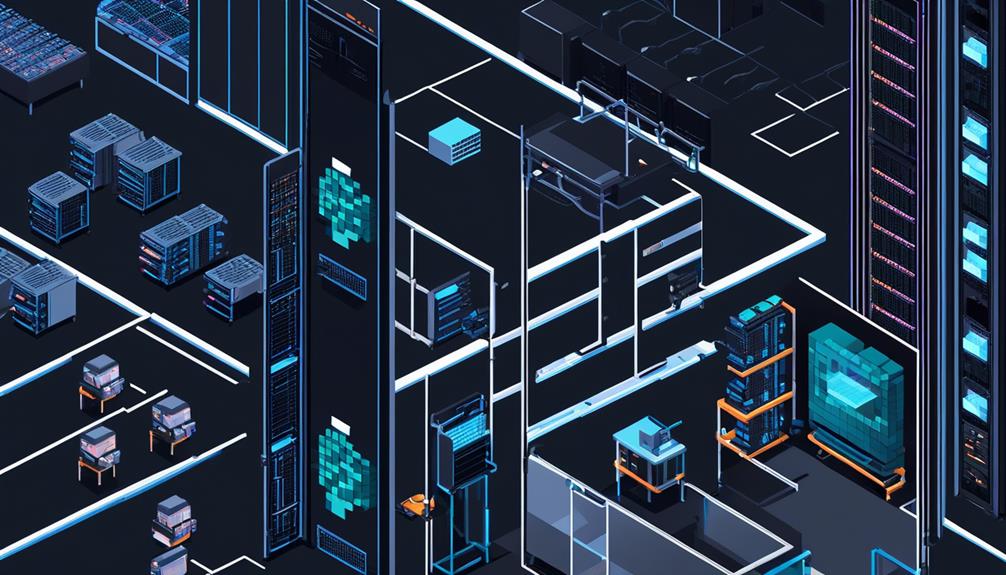In today's rapidly evolving digital landscape, data centers play a crucial role in supporting the ever-increasing demands of businesses and organizations.
Virtualization hardware, as the backbone of these data centers, holds the key to unlocking their full potential. But what exactly does virtualization hardware entail? How does it contribute to the efficiency and scalability of data centers? And what challenges may arise when implementing and utilizing this vital technology?
In this discussion, we will explore the intricacies of virtualization hardware, its benefits and components, and delve into real-world case studies to uncover its successful deployments.
So, let us embark on this journey to uncover the power and significance of virtualization hardware in the realm of data centers.
Key Takeaways
- Virtualization hardware offers numerous benefits and features, including optimized resource utilization, cost savings, increased scalability, simplified automation and updates, enhanced disaster recovery, performance optimization, flexible resource allocation, CPU and memory management, enhanced I/O virtualization, and hardware offload.
- Understanding virtualization hardware components is crucial, including the hypervisor software (virtual machine monitor), hardware consolidation and optimization, different types of virtualization technology (server, storage, application, desktop, network), creation and management of virtual machines, and support for various types of virtualization technology.
- Hardware requirements for virtualization include high processing power, ample memory, sufficient storage capacity, network capabilities, and hardware flexibility.
- When choosing and evaluating virtualization hardware, factors such as scalability, integration capabilities, deployment options, workload requirements, compatibility with existing infrastructure, and evaluating the ROI of virtualization hardware should be considered.
Benefits of Virtualization Hardware
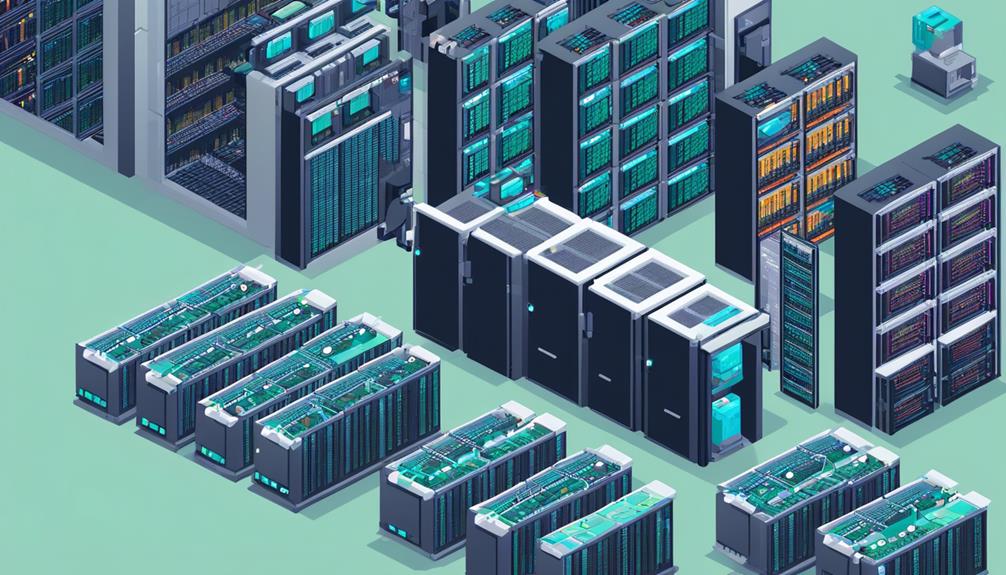
Virtualization hardware offers numerous advantages for data centers. This includes optimized resource utilization, cost savings, and increased scalability. By leveraging virtualization technology, organizations can efficiently manage their data centers and reduce power and space requirements compared to traditional physical setups.
One of the key benefits of virtualization hardware is its ability to simplify automation and updates. With virtualization, data centers become more versatile and cost-effective. Organizations can easily deploy and manage virtual machines, enabling them to quickly adapt to changing business needs. This not only saves time and effort but also reduces operational costs.
Another advantage of virtualization hardware is its potential for cost savings and enhanced disaster recovery. By virtualizing resources, organizations can consolidate their physical infrastructure, reducing the number of physical servers required. This leads to lower hardware and maintenance costs. Additionally, virtualization enables efficient disaster recovery strategies, ensuring business continuity in case of system failures or disasters.
Virtualization hardware also provides increased scalability and resource utilization. Virtual machines can be quickly provisioned and scaled up or down as needed, allowing data centers to respond dynamically to workload fluctuations. Moreover, virtualization allows for improved hardware redundancy by distributing workloads across multiple virtual machines and physical servers. This enhances system availability and minimizes downtime.
Furthermore, virtualized resources can be accessed remotely, improving productivity and facilitating greater flexibility and agility in managing data centers. Administrators can manage and monitor virtual machines from anywhere, reducing the need for physical presence in the data center. This remote accessibility enables faster troubleshooting and maintenance, resulting in improved operational efficiency.
Understanding Virtualization Hardware Components
With a solid understanding of the benefits of virtualization hardware in data centers, it is important to now delve into the components that make up this essential technology. Virtualization hardware plays a crucial role in the overall data center architecture, enabling the virtualization of physical hardware resources and the creation of virtual machines (VMs). Here are the key components to understand:
- Hypervisor Software: The hypervisor software, also known as the virtual machine monitor (VMM), is responsible for abstracting the physical hardware and managing the creation, execution, and management of VMs. It allows multiple VMs to run on a single physical server, maximizing hardware utilization and efficiency.
- Hardware Consolidation and Optimization: Virtualization hardware enables hardware consolidation by allowing multiple VMs to run on a single physical server. This consolidation leads to improved resource utilization and reduces the number of physical servers required, resulting in cost savings and a smaller data center footprint.
- Types of Virtualization Technology: Virtualization technology extends beyond server virtualization. Other types include storage virtualization, application virtualization, desktop virtualization, and network virtualization. Each type focuses on different aspects of the data center environment, providing flexibility, scalability, and easier management.
Virtualization hardware is a critical component of virtualized data centers. It enables the creation and management of virtual machines, improves hardware utilization through consolidation, and supports various types of virtualization technology. By understanding these components, organizations can harness the power of virtualization to optimize their data center resources, improve scalability, and achieve cost savings.
Key Features of Virtualization Hardware
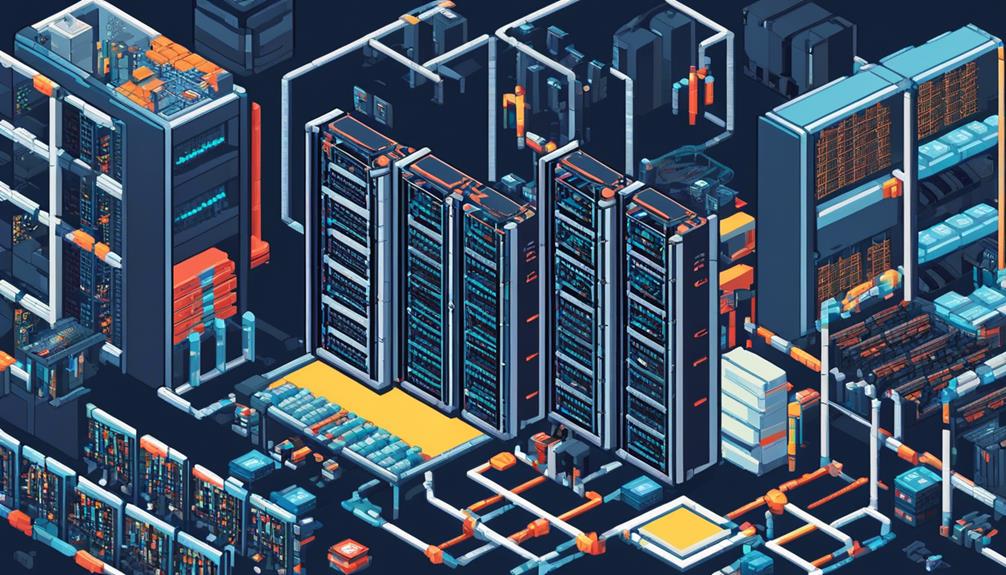
One of the key features of virtualization hardware is performance optimization. Virtualization hardware is designed to maximize the performance of virtual machines by efficiently allocating resources such as CPU, memory, and storage.
This ensures that each virtual machine runs at its optimal capacity, resulting in improved overall system performance.
Additionally, virtualization hardware enables flexible resource allocation, allowing data centers to dynamically allocate resources to different virtual machines based on their specific needs, further enhancing performance and efficiency.
Performance Optimization
Performance optimization is a crucial aspect of virtualization hardware, as it aims to maximize system efficiency and improve overall performance by effectively utilizing physical hardware resources.
To achieve this, virtualization hardware offers several key features:
- CPU and memory management: Virtualization hardware ensures workload balancing by efficiently managing CPU and memory resources, allowing for optimal utilization and performance of virtualized servers in both physical and virtual data centers.
- Enhanced I/O virtualization: By improving data transfer and access speeds, virtualization hardware enhances I/O virtualization capabilities. This results in faster and more efficient communication between virtual servers and storage devices, reducing latency and improving overall system performance.
- Hardware offload: Virtualization hardware provides hardware offload features for tasks such as network and storage processing. Offloading these tasks to dedicated hardware accelerators reduces latency, improves performance, and frees up CPU resources for other critical tasks.
Resource Allocation
Efficient resource allocation is a crucial aspect of virtualization hardware, allowing for optimal utilization of virtualized servers and virtual machines (VMs) in both physical and virtual data centers. By effectively allocating resources, data center virtualization enables scalability and flexibility to meet changing needs. This is achieved through the ability to adjust and fine-tune resource utilization on the fly, simplifying resource provisioning and allowing for greater flexibility in adjusting resources as needed. Additionally, virtualization hardware enhances disaster recovery and backup processes by providing frequent snapshots of virtual resources and a consolidated recovery site for quick machine movement. Furthermore, virtualization hardware reduces hardware costs and energy consumption by utilizing fewer physical resources and more efficient cooling. The table below illustrates the benefits of resource allocation in virtualized data centers.
| Benefits of Resource Allocation in Virtualized Data Centers |
|---|
| Scalability to meet changing needs |
| Simplified resource provisioning |
| Enhanced disaster recovery and backup processes |
| Reduced hardware costs and energy consumption |
| Optimal utilization of virtual resources |
Importance of Virtualization Hardware in Data Centers
Virtualization hardware plays a crucial role in data centers by providing numerous benefits. These benefits include resource optimization, scalability, and energy efficiency. Virtualization hardware enables data centers to reduce power and space requirements, resulting in improved energy utilization. Additionally, it simplifies data center automation and enables cost savings. As a result, virtualization hardware is an essential component for modern data centers.
Benefits of Virtualization
The hardware utilized in data centers plays a key role in harnessing the benefits of virtualization. Virtualization offers numerous advantages that can greatly enhance the efficiency and effectiveness of data centers. Here are some of the benefits of virtualization:
- Reduced power and space requirements: Virtualization allows for the consolidation of multiple physical servers into virtual machines, resulting in significant reductions in power consumption and space requirements.
- Simplified automation and updates: Virtualization simplifies the process of automating tasks and updating software, leading to improved operational efficiency and reduced downtime.
- Cost savings through resource utilization: Virtualization enables the efficient utilization of virtualized resources, allowing data centers to maximize their hardware investments and reduce maintenance costs.
Hardware Requirements for Virtualization
Optimizing data centers for efficient performance and scalability requires careful consideration of hardware requirements for virtualization.
Virtualization, a key component of modern data centers and cloud environments, relies on specialized hardware to create and manage virtual machines (VMs) that abstract physical resources.
To support multiple VMs and workloads, virtualization hardware must provide high processing power, ample memory, and sufficient storage capacity.
Additionally, network capabilities and hardware flexibility are crucial for seamless integration and management of virtual data centers.
Investing in virtualization hardware enables efficient resource utilization, cost savings, and improved disaster recovery capabilities.
Common Types of Virtualization Hardware

Common types of virtualization hardware, such as x86 servers, storage area networks (SAN), and network interface cards (NICs), play a crucial role in optimizing data center performance. These hardware components are essential for server virtualization, enabling multiple virtual machines (VMs) to run on a single physical server.
Here are some common types of virtualization hardware and their importance in data center environments:
- x86 Servers: x86 servers are the foundation of virtualization in data centers. They provide the processing power and memory needed to host multiple VMs simultaneously. These servers are designed to handle the demands of virtualization workloads efficiently, ensuring smooth operation and resource allocation.
- Storage Area Networks (SAN): SANs are dedicated networks that provide high-speed access to storage resources for virtualized environments. They allow VMs to access shared storage, improving data availability and enabling advanced features like live migration. SANs also enhance data protection and disaster recovery capabilities in a virtualized environment.
- Network Interface Cards (NICs): NICs are responsible for connecting servers and VMs to the network. Virtualization-aware NICs offer advanced features like hardware acceleration and offloading, improving network performance and reducing CPU overhead. They also support technologies like virtual LANs (VLANs) and network virtualization, enabling efficient network management in virtualized environments.
Choosing the Right Virtualization Hardware for Your Data Center
When selecting virtualization hardware for your data center, it is crucial to carefully evaluate the scalability, integration capabilities, and deployment options of the available options. Choosing the right virtualization hardware can significantly impact the performance and efficiency of your data center, so it's important to consider a few key factors.
Firstly, scalability is a vital aspect to consider. Your virtualization hardware should be able to handle the increasing demands of your data center as your business grows. It should have the capacity to support a large number of virtual machines and provide the necessary resources to meet the workload requirements.
Secondly, integration capabilities are essential for seamless operation within your data center. The virtualization hardware should be compatible with your existing infrastructure, including storage systems, network devices, and management tools. Integration with other vendor products and services is also important, as it enables you to leverage additional functionalities and features.
Lastly, deployment options play a significant role in choosing the right virtualization hardware. You need to determine whether you want to deploy on-premises or opt for cloud-based virtualization services. Each option has its pros and cons, and the decision should be based on your specific requirements, budget, and business objectives.
To help you in the decision-making process, consider the following table showcasing some popular virtualization hardware options:
| Virtualization Hardware | Scalability | Integration Capabilities | Deployment Options |
|---|---|---|---|
| Hardware A | High | Good | On-premises |
| Hardware B | Medium | Excellent | Cloud-based |
| Hardware C | Low | Average | On-premises |
Factors to Consider When Selecting Virtualization Hardware
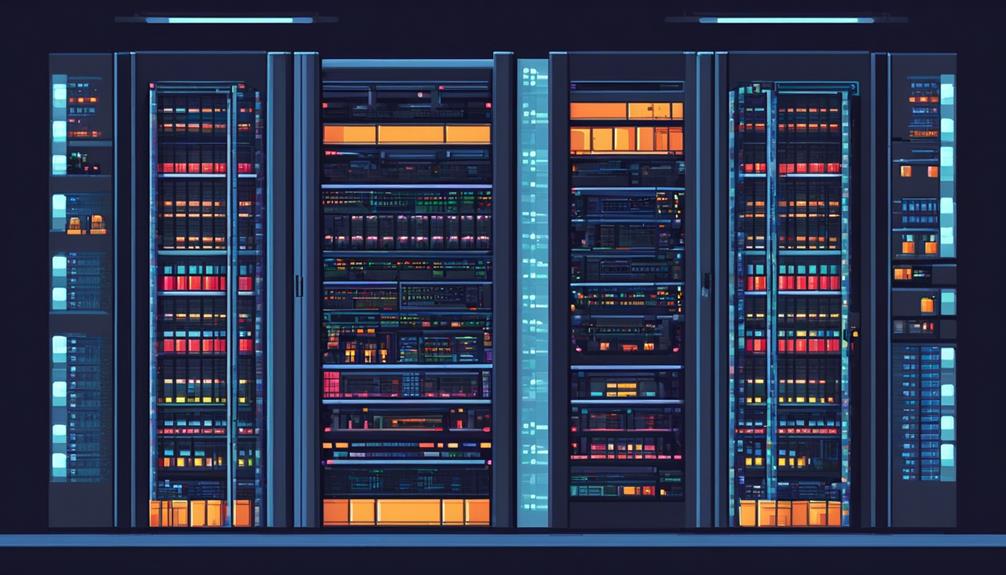
As we shift our focus to the factors that should be taken into consideration when selecting virtualization hardware, it is crucial to thoroughly evaluate various aspects that can significantly impact the performance and efficiency of your data center. Choosing the right virtualization hardware is a critical decision that can have long-term implications for your organization.
To assist you in making an informed decision, here are three key factors to consider:
- Performance and Scalability: Evaluate the hardware's capacity to handle the virtualized workloads and support scalability as the organization's needs grow. Look for hardware that offers robust processing power, sufficient memory, and high-speed connectivity to ensure optimal performance even under heavy workloads.
- Compatibility and Integration: Consider the hardware's compatibility with existing infrastructure and its ability to integrate with other vendor products and services. Ensure that the virtualization hardware can seamlessly integrate with your storage systems, networking equipment, and management tools to avoid any operational disruptions and maximize efficiency.
- Reliability and Redundancy: Assess the hardware's reliability features, such as failover capabilities and redundancy, to ensure high availability of virtualized resources. Look for hardware that offers built-in redundancy at various levels, including power supplies, network connections, and storage systems, to minimize the risk of downtime and data loss.
Best Practices for Implementing Virtualization Hardware
To ensure optimal performance and efficiency of a virtualized data center, implementing best practices for selecting and deploying virtualization hardware is essential. These best practices help organizations make contextually relevant decisions that align with their specific needs and scalability requirements. By following these guidelines, data centers can enhance the overall effectiveness of their virtualization infrastructure.
One crucial aspect of implementing virtualization hardware is ensuring robust security measures. Data centers must protect virtualized systems and data from potential threats and vulnerabilities. This includes implementing firewalls, intrusion detection systems, and encryption protocols. Regular security audits should also be conducted to identify and address any weaknesses.
Monitoring and optimizing the performance of virtualized hardware is another essential best practice. By regularly monitoring resource utilization, data centers can identify bottlenecks and optimize performance. This proactive approach minimizes downtime and ensures efficient resource allocation.
Establishing comprehensive backup and disaster recovery processes is also critical. Data centers must have mechanisms in place to safeguard virtualized data and applications in case of unexpected incidents or system failures. This includes regularly backing up virtual machines and ensuring there are redundant systems to prevent data loss.
Staying updated on industry best practices and technological advancements is vital for continuously enhancing the virtualization hardware infrastructure. By keeping abreast of the latest trends and innovations, data centers can make informed decisions and ensure their virtualization hardware remains cutting-edge.
The table below summarizes the best practices for implementing virtualization hardware in data centers:
| Best Practices |
|---|
| Align hardware with needs and scalability requirements |
| Implement robust security measures |
| Regularly monitor and optimize performance |
| Establish comprehensive backup and disaster recovery processes |
| Stay updated on industry best practices and technological advancements |
Maximizing Performance With Virtualization Hardware
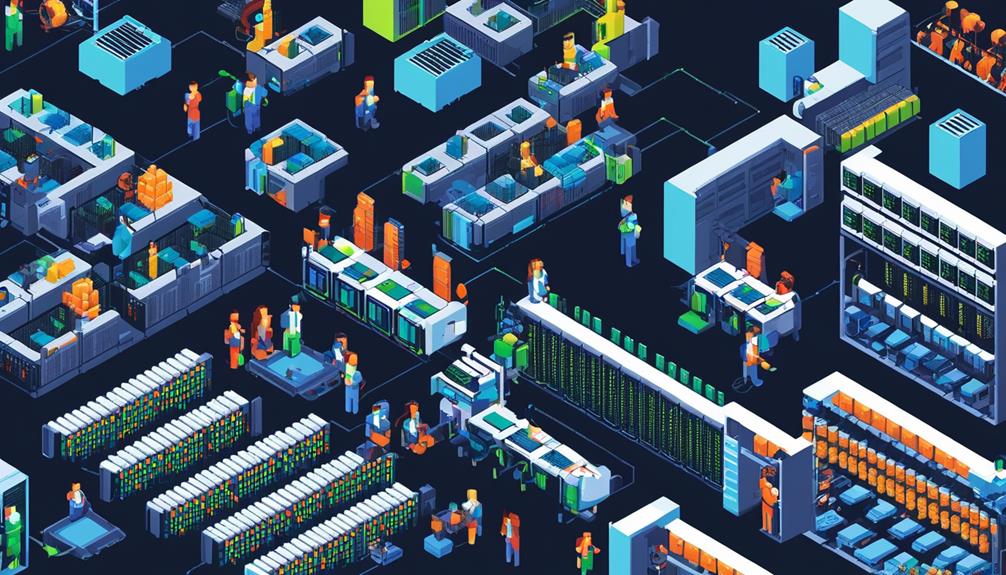
Maximizing performance with virtualization hardware involves leveraging its capabilities to enhance efficiency and optimize resource utilization in data center environments. By implementing the right virtualization hardware, data centers can experience significant improvements in their overall performance.
Here are three key ways to maximize performance with virtualization hardware:
- Consolidation and Server Utilization: Virtualization hardware allows for the consolidation of multiple virtual servers on a single physical server. This consolidation leads to greater server utilization, as resources are efficiently distributed among virtual machines. With virtualization, data centers can achieve higher levels of server utilization, reducing the number of physical servers required and optimizing resource allocation.
- Faster Deployment and Scalability: Virtualization hardware enables faster deployment of virtual machines, allowing data centers to rapidly scale their infrastructure. Virtual machines can be provisioned and deployed within minutes, compared to the hours or days it may take to deploy physical servers. This increased agility and scalability help data centers meet the demands of dynamic workloads and changing business needs.
- Improved Management and Maintenance: Virtualization hardware simplifies the management and upgrade of hardware in data centers. With virtualization, administrators can easily manage and monitor virtual machines from a centralized console, reducing the time and effort required for maintenance tasks. Additionally, virtualization hardware integrates effectively with cloud data services, enabling data centers to leverage the benefits of cloud computing while maintaining control over their infrastructure.
Virtualization Hardware Management and Monitoring
Virtualization hardware management and monitoring play a crucial role in maintaining the performance and health of virtualized infrastructure.
Performance monitoring tools offer real-time insights into resource utilization, allowing for proactive capacity planning and optimization.
Additionally, hardware resource optimization ensures efficient allocation of resources, maximizing the efficiency of virtual machines and overall data center operations.
Performance Monitoring Tools
Performance monitoring tools are essential for managing and optimizing the virtualization hardware in data centers, providing real-time insights into resource usage and ensuring efficient workload management.
Here are three key benefits of using performance monitoring tools in the virtual ecosystem:
- Visibility: These tools offer a comprehensive view of virtual machines, hypervisors, and physical hardware, allowing administrators to monitor and analyze performance metrics in real-time. This visibility helps identify and troubleshoot performance bottlenecks, ensuring optimal server utilization.
- Capacity Planning: Performance monitoring tools track historical data and trends, enabling capacity planning and optimization. By analyzing resource usage patterns, administrators can make informed decisions to allocate resources effectively, avoiding over-provisioning or underutilization.
- Proactive Maintenance: These tools facilitate proactive maintenance and issue resolution, ensuring high availability and performance levels. By monitoring performance metrics, administrators can detect and address potential issues before they impact the virtual ecosystem.
Hardware Resource Optimization
Efficient management and optimization of hardware resources play a critical role in ensuring optimal performance and cost savings in virtualization environments.
Virtualization enables the consolidation of multiple virtual machines (VMs) onto a single physical server, reducing the need for traditional data centers with multiple hardware servers.
Hardware resource optimization involves real-time monitoring and allocation of these resources to ensure their efficient utilization. By identifying and eliminating underutilized or overprovisioned hardware resources, organizations can avoid unnecessary costs and improve overall performance.
Proactive identification and resolution of hardware resource bottlenecks or performance issues further enhance the virtual infrastructure's efficiency.
Integration of hardware resource management with automation tools streamlines data center operations, enabling automated allocation and optimization of hardware resources across different data center platforms.
Virtual Machine Health Monitoring
Virtual Machine Health Monitoring plays a crucial role in ensuring the smooth operation and optimal performance of virtual machines within a virtualization hardware environment. Here are three key benefits of implementing virtual machine health monitoring:
- Real-time insights: Virtual Machine Health Monitoring provides real-time insights into the performance and status of virtual machines. It enables proactive identification and resolution of issues such as resource contention, bottlenecks, and abnormal behavior.
- Resource optimization: By monitoring CPU, memory, and storage utilization, virtual machine health monitoring helps optimize resource allocation. It allows administrators to allocate resources efficiently and avoid overprovisioning or underutilization.
- Performance tracking: Virtual machine health monitoring enables the tracking of key performance metrics for virtual machines. This ensures efficient and reliable operation by identifying any performance degradation or anomalies.
Future Trends in Virtualization Hardware for Data Centers
In the realm of data centers, the future of virtualization hardware is poised for significant advancements, with a particular focus on energy efficiency and reduced carbon footprint. As data centers continue to grow in size and complexity, there is a pressing need for virtualization hardware that can effectively support the increasing demands of virtual machine (VM) workloads while minimizing power consumption and environmental impact.
One of the key future trends in virtualization hardware for data centers is the push towards software-defined data centers (SDDCs). This approach involves abstracting the underlying hardware infrastructure and delivering it as a service, enabling more efficient resource allocation and management. By decoupling the hardware from the software, SDDCs allow for greater flexibility and scalability, making it easier to provision and manage multiple virtual machines.
Another emerging trend is the integration of specialized hardware accelerators, such as Graphics Processing Units (GPUs) and Field-Programmable Gate Arrays (FPGAs), into virtualization platforms. These accelerators can enhance performance and enable data centers to efficiently handle high-performance computing and artificial intelligence workloads.
Disaggregated hardware architectures are also gaining traction in the virtualization space. This approach involves separating the different components of a traditional server, such as CPU, memory, and storage, into distinct modules. This allows for more granular resource allocation and better utilization of hardware resources, leading to improved efficiency and cost savings.
Furthermore, future virtualization hardware is expected to incorporate security-focused features and technologies. This includes hardware-based encryption and secure enclaves to address data protection and compliance requirements in data centers, ensuring the integrity and confidentiality of sensitive information.
Evaluating the ROI of Virtualization Hardware
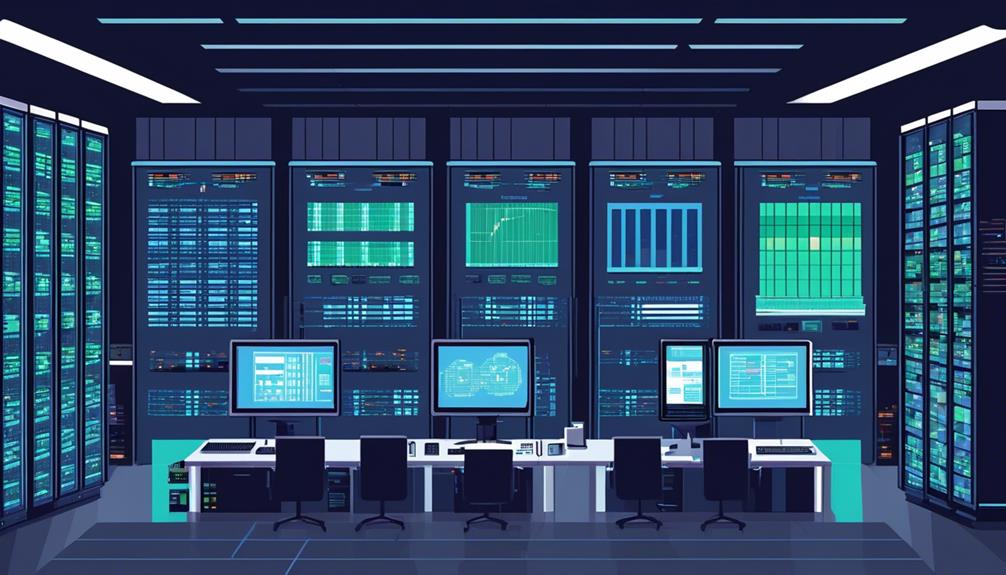
As organizations explore the potential benefits and advancements of virtualization hardware for data centers, evaluating the return on investment (ROI) becomes a crucial consideration.
To effectively evaluate the ROI of virtualization hardware, organizations should consider the following:
- Cost savings: One of the primary reasons for implementing virtualization hardware is to reduce costs compared to traditional data centers. By replacing on-site virtualized servers with cloud software, organizations can avoid the upfront expenses associated with purchasing and maintaining physical hardware. Additionally, virtualization hardware allows organizations to create multiple simulated data centers using a single physical server, further reducing business expenses.
- Operational costs: While the initial investment in virtualization hardware may be lower, organizations must also consider the ongoing operational costs. This includes factors such as licensing fees, maintenance and support, and energy consumption. By carefully assessing these costs, organizations can determine the long-term ROI of virtualization hardware.
- Benefits and efficiency: In addition to cost savings, evaluating the ROI of virtualization hardware requires assessing the potential benefits it offers. These include improved efficiency through resource consolidation, increased scalability for rapidly growing businesses, and reduced maintenance requirements. By quantifying these benefits, organizations can better understand the value virtualization hardware brings to their operations.
Evaluating the ROI of virtualization hardware goes beyond financial considerations. Organizations must also assess how it aligns with their strategic goals and the potential return on investment in the long term.
Overcoming Challenges in Virtualization Hardware Implementation
To successfully implement virtualization hardware, organizations must overcome various challenges to ensure optimal application performance and data access. Addressing performance and latency concerns is crucial in virtualization hardware implementation. Organizations need to carefully consider factors such as CPU and memory allocation, network bandwidth, and storage capacity to ensure that virtualized applications perform at their best. This involves optimizing hardware configurations and resource allocation to maximize the efficiency and utilization of virtualization technology.
Another challenge in virtualization hardware implementation is maintaining high availability and reliability. Organizations need to implement hardware redundancy and failover mechanisms to minimize downtime and ensure uninterrupted access to critical applications and data. This includes utilizing technologies like clustering, load balancing, and data replication to create a resilient virtualized environment.
Seamless integration of virtualization hardware with existing infrastructure and applications is also a key challenge. Compatibility issues can arise when integrating virtualization hardware with legacy systems or specialized applications. Organizations need to carefully plan and test the implementation process to ensure that the virtualization hardware works seamlessly with the existing infrastructure, minimizing disruptions and compatibility issues.
Security is another significant challenge in virtualization hardware implementation. Organizations must implement robust hardware-level security measures to mitigate security risks and ensure compliance with industry standards. This includes implementing features like secure boot, hardware-based encryption, and secure virtualized environments to protect sensitive data and prevent unauthorized access.
Case Studies: Successful Deployments of Virtualization Hardware
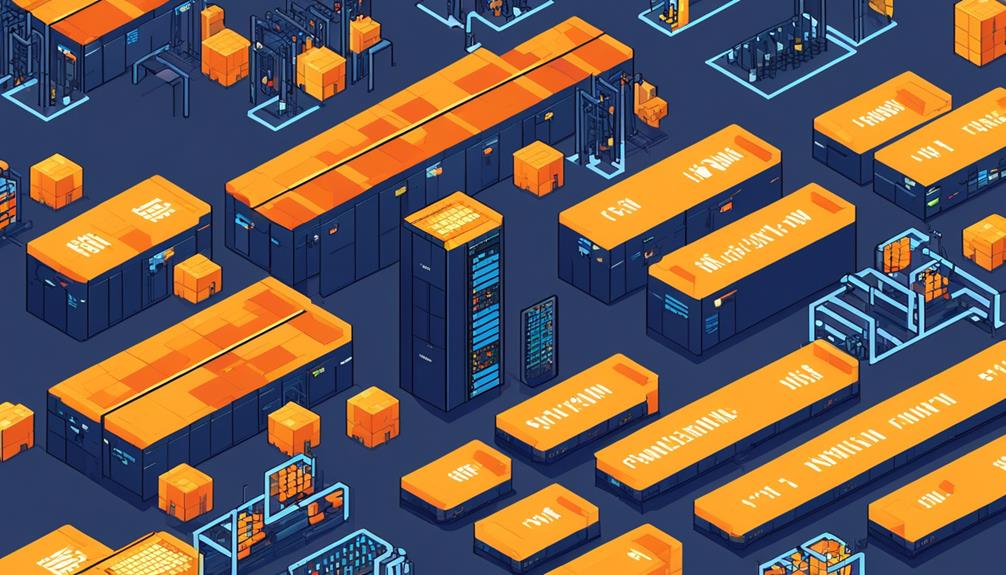
What are some examples of successful deployments of virtualization hardware in data centers, and how have they benefited organizations?
Successful deployments of virtualization hardware have showcased the transformative impact it can have on data centers, providing organizations with numerous benefits. Here are three case studies that illustrate the advantages of virtualization hardware:
- Company A:
By deploying virtualization hardware, Company A was able to optimize their data center operations and achieve significant cost savings. The virtualization technology enabled them to consolidate their physical servers, reducing power and space requirements. With fewer physical servers to maintain, they were able to allocate their limited maintenance staff to other critical tasks. This resulted in improved efficiency and reduced operational costs.
- Company B:
Integration with other vendor products and services played a crucial role in the successful deployment of virtualization hardware for Company B. By combining virtualization hardware with their existing storage solutions, they were able to enhance data management and simplify automation processes. This integration allowed them to seamlessly scale their data center operations as their needs evolved, providing them with greater flexibility and agility.
- Company C:
Virtualization hardware deployments have shown potential for significant cost savings compared to traditional data centers. Company C implemented virtualization hardware and experienced a drastic reduction in hardware costs, as they no longer needed to purchase and maintain a large number of physical servers. Additionally, the virtualization technology allowed them to efficiently allocate computing resources, resulting in improved utilization rates and further cost reductions.
These case studies highlight the contextually relevant benefits of virtualization hardware in data centers. The successful deployments demonstrate how virtualization hardware can optimize operations, reduce costs, and provide organizations with the scalability and flexibility they need to adapt to changing business requirements.
Tips for Troubleshooting Virtualization Hardware Issues
Troubleshooting virtualization hardware issues requires a systematic approach that involves checking physical connections, monitoring resource usage, verifying compatibility and firmware updates, using diagnostic tools, and reviewing software logs and event data. By following these tips, data center administrators can effectively identify and resolve hardware problems to ensure the smooth operation of their virtualization infrastructure.
Firstly, it is important to check physical connections and cabling for any loose or faulty connections. Ensure that all cables are securely connected to their respective ports and that there are no breaks or damage in the wiring. A simple loose cable can cause intermittent connectivity issues and impact the performance of virtual machines.
Monitoring resource usage and performance metrics is another crucial aspect of troubleshooting virtualization hardware issues. Keep an eye on metrics such as CPU usage, memory utilization, and disk I/O to identify potential bottlenecks. This can help pinpoint the specific hardware component that might be causing performance degradation.
Verifying compatibility and firmware updates for hardware components is essential to ensure optimal performance and compatibility with the virtualization software. Regularly check for updates from the hardware vendors and apply them as necessary to address any known issues or vulnerabilities.
Using diagnostic tools can greatly assist in troubleshooting hardware issues. These tools can help identify and diagnose problems such as memory errors or disk failures. They provide valuable insights into the health and status of various hardware components, allowing administrators to take appropriate actions.
Lastly, reviewing virtualization software logs and event data can provide valuable information about hardware-related errors or warnings. These logs can help identify patterns or recurring issues that might point towards specific hardware components experiencing problems.
By following these troubleshooting tips, data center administrators can effectively address virtualization hardware issues and ensure the smooth operation of their data centers. The table below summarizes these tips for easy reference:
| Troubleshooting Tips for Virtualization Hardware Issues |
|---|
| 1. Check physical connections and cabling. |
| 2. Monitor resource usage and performance metrics. |
| 3. Verify compatibility and firmware updates. |
| 4. Use diagnostic tools to identify and troubleshoot issues. |
| 5. Review software logs and event data. |
Frequently Asked Questions
What Is Virtualization in Data Centers?
Virtualization in data centers refers to the process of creating virtual versions of physical infrastructure. This includes servers, storage, applications, desktops, and networks. By doing so, businesses can enjoy a range of benefits. These include cost reduction, increased scalability, and improved performance. To implement virtualization, specialized software is required. This software allows businesses to remotely access information and applications. As a result, management becomes simpler and maintenance costs decrease. However, there are challenges involved in virtualization. These include compatibility issues and security concerns. To address these challenges, organizations can look to best practices and case studies for guidance. Additionally, future trends in virtualization include advancements in automation and containerization.
What Hardware Is Used in Data Centers?
Data centers rely on a variety of hardware components to support their operations. These include servers, storage devices, networking equipment, and cooling systems.
Specialized hardware, such as hypervisors and virtual switches, play a crucial role in virtualization. High-performance computing hardware, like GPUs and specialized processors, may be used for demanding workloads.
Power distribution units, uninterruptible power supplies, and backup generators ensure uptime. Advanced security hardware, such as firewalls and encryption appliances, protect data center assets.
Can a Data Center Be Fully Virtualized?
Fully virtualizing a data center is indeed possible and offers numerous benefits. However, there are potential challenges to consider, such as the need for robust hardware resources and ensuring the security of virtualized environments.
Best practices for virtualizing a data center include thorough planning, efficient resource allocation, and regular performance monitoring.
Additionally, case studies of companies that have successfully fully virtualized their data centers can provide valuable insights into the implementation process and the impact on performance.
What Hypervisor Do Data Centers Use?
Data centers use a variety of hypervisors, including VMware vSphere, Microsoft Hyper-V, and Citrix Hypervisor, to enable virtualization. Hypervisors offer numerous benefits, such as improved resource utilization and flexibility.
When choosing a hypervisor, factors like performance, scalability, integration capabilities, and cost-effectiveness must be considered. Implementing hypervisor virtualization in data centers can present challenges, but best practices for management and security considerations help mitigate risks.
Future trends in hypervisor technology are focused on enhancing efficiency and enabling advanced features for data centers.
